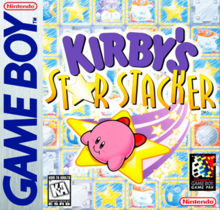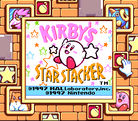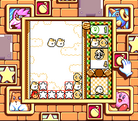| Kirby's Star Stacker |
|---|
 |
| Developer(s) | HAL Laboratory |
|---|
| Publisher(s) | Nintendo |
|---|
| Platform(s) | Game Boy, SF Memory (NP), Super Famicom |
|---|
| Release | Game Boy SF Memory (NP) Super Famicom |
|---|
| Gameplay info |
|---|
| Next pieces | 1 |
|---|
| Playfield size | 6 × 9 |
|---|
| Hard drop | No |
|---|
| Rotation system | Sideways, 90 degrees |
|---|
|
Kirby's Star Stacker is a game released for the Game Boy in 1997 developed by HAL Laboratory and published by Nintendo. The game would also see a release for the Super Famicom, initially as an SF Memory Nintendo Power game in 1998 before receiving a retail release in 1999 only in Japan.
Gameplay
This game is played by placing 2-block pieces (dominoes) into a 6x9 playfield. As with most puzzle games of this type, the dominoes can be rotated at 90-degree angles. Each block of a domino can be a star block, or an image of Coo the Owl, Rick the Hamster, or Kine the Fish. The overall goal of the game is to prevent the blocks from piling up to the top of the screen by clearing them. Star blocks can be cleared by sandwiching them between a pair of matching friend blocks. If two or more matching friend blocks are placed so their edges touch, they are cleared. Blocks can fall to form a group if the blocks underneath them are cleared. If a chain reaction is formed this way, then a number of stars will fall down to the field, briefly filling in the spaces where they land. These act as star blocks for a moment before the next piece falls, then disappear. If they fill in the space(s) between two matching friend blocks, another group is formed and cleared. For each group in a chain reaction, more stars fall down, making it easier to form another one.
| Tetris and other puzzle games published by Nintendo
|
|
|
| Console releases
|
|
|
|
| Handheld releases
|
|
|
|
| Topics
|
|
|
|
| Other puzzle games
|
|
|


